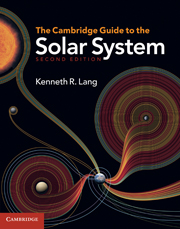Book contents
- Frontmatter
- Contents
- List of focus elements
- List of tables
- Preface to the second edition
- Preface to the first edition
- Principal units
- Part 1 Changing views and fundamental concepts
- Part 2 The inner solar system: rocky worlds
- Part 3 The giant planets, their satellites and their rings: worlds of liquid, ice and gas
- Part 4 Remnants of creation: small worlds in the solar system
- 12 Asteroids and meteorites
- 13 Colliding worlds
- 14 Comets
- 15 Beyond Neptune
- Part 5 Origin of the solar system and extrasolar planets
- Author index
- Subject index
14 - Comets
from Part 4 - Remnants of creation: small worlds in the solar system
Published online by Cambridge University Press: 05 August 2011
- Frontmatter
- Contents
- List of focus elements
- List of tables
- Preface to the second edition
- Preface to the first edition
- Principal units
- Part 1 Changing views and fundamental concepts
- Part 2 The inner solar system: rocky worlds
- Part 3 The giant planets, their satellites and their rings: worlds of liquid, ice and gas
- Part 4 Remnants of creation: small worlds in the solar system
- 12 Asteroids and meteorites
- 13 Colliding worlds
- 14 Comets
- 15 Beyond Neptune
- Part 5 Origin of the solar system and extrasolar planets
- Author index
- Subject index
Summary
• The sudden apparition, changing shapes, and unpredictable movements of comets have puzzled humanity for centuries. To ancient cultures they were harbingers of disaster and portents of great events.
• Comet Halley has returned to fascinate and frighten the world for more than 2000 years.
• Long-period comets, with orbital periods greater than 200 years, have been tossed into the planetary realm from a remote, spherical shell, named the Oort cloud, located about a quarter of the way to the nearest star.
• A million million (1012) invisible comets have been hibernating in the deep freeze of the Oort comet cloud since the formation of the solar system 4.6 billion years ago.
• Many Jupiter family comets, with orbital periods of less than 20 years, probably came from the Kuiper belt, which lies in the outer disk of the planetary system beyond the orbit of Neptune and may contain more than a billion unseen comets.
• Comets light up and become visible for just a few weeks or months when their orbits bring them near the Sun. The solar heat then vaporizes some of the comet water ices, permitting the comets to grow large enough to be seen. The water ice sublimates, or turns directly from solid ice to water vapor.
• The solid comet nucleus is just a gigantic ball of water ice, other ices, dust and rock. Some of the comet nuclei are about the size of Paris or Manhattan and roughly one-billionth the mass of the Earth. Other comets are much smaller. […]
Information
- Type
- Chapter
- Information
- The Cambridge Guide to the Solar System , pp. 408 - 434Publisher: Cambridge University PressPrint publication year: 2011
